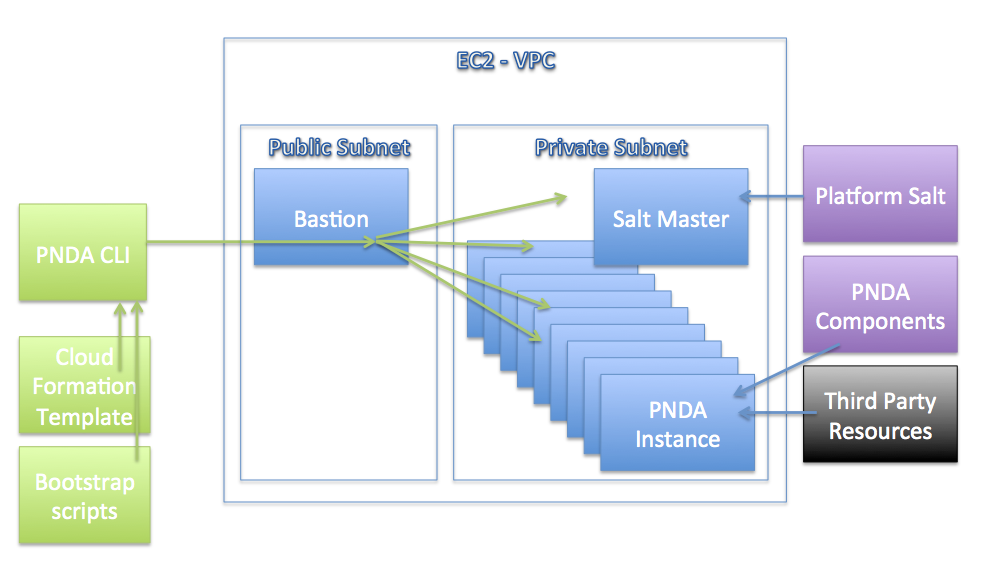This repository contains resources for launching PNDA on Amazon Web Services (AWS).
- The blocks in green are provided by this repository.
- Cloud formation templates are used to create the instances and other cloud infrastructure in EC2.
- PNDA is launched in a private network in a custom VPC as specified by the cloud formation templates. For security reasons all access is then controlled via a bastion node, the only one with a public IP address. The CLI generates some sample ssh configuration files to help with accessing the cluster via the bastion.
- The instances are bootstrapped to install the saltstack provisioning system.
- The platform-salt salt scripts are used to install PNDA from PNDA components and third party components.
- Obtain an AWS account.
- Create buckets in S3 for PNDA applications (pnda-apps/releases) and for archived data (pnda-archive). AWS credientials should be created for an IAM user with access to these specific S3 buckets only. For help creating a user with these permissions, please refer here.
-
Copy
pnda_env_example.yamlto createpnda_env.yaml -
Edit pnda_env.yaml with AWS credentials and an Ubuntu 14.04 image ID. Regarding the AMI, you should select an AMI with type HVM as we are using instance type t2 and m3 (for more details, you can find more details on AWS Virtualization types). At least two sets of AWS credientials should be supplied:
- One set with access to EC2 and cloud formation used to create PNDA, these are only ever stored on the client machine.
- One or more set created for the IAM user(s) with access to the specific S3 buckets only as these credentials will be stored in plain text on some of the nodes launched in AWS. For help creating a user with these permissions, please refer here.
-
Edit pnda_env.yaml with the component package server IP address. A component package server provides a webserver for the binaries for the pnda components, the PNDA guide contains instructions on how to set up a component package server.
-
Create an ssh keypair to use when creating the EC2 instances for PNDA (link) as
key_name. Place the private keykey_name.pemin the root of the pnda-aws-templates directory. Ensure that key_name.pem has 0600 permissions. -
Install pip packages required by the CLI
cd cli sudo pip install -r requirements.txt -
Create a cluster:
cd cli pnda-cli.py create -e <cluster_name> -s <key_name> -f standard -o 2 -n 3 -k 2 -z 3
The options shown select the standard flavor, 2 open tsdb instances, 3 hadoop datanodes, 2 kafka brokers, and 3 zookeeper nodes. If you need to operate within the default EC2 instance quota of 20 instances then you can reduce this to 1 kafka and 1 zookeeper instance or use the pico flavor.
pnda-cli.py create -e <cluster_name> -s <key_name> -f standard -o 1 -n 1 -k 1 -z 1 pnda-cli.py create -e <cluster_name> -s <key_name> -f pico -n 1 -k 1
The cloud formation templates for PNDA can be edited directly to make modications as required.
The organisation and contents of the cloud formation templates is described here
